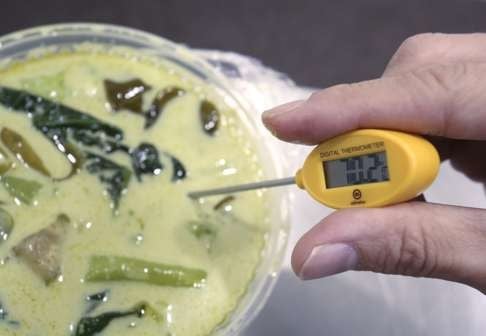
Foodpanda vs Deliveroo vs UberEats: Hong Kong food delivery services put to the test
We try out the apps and services of the three main Hong Kong companies delivering restaurant meals to your door or office – and hear the gripes of some customers
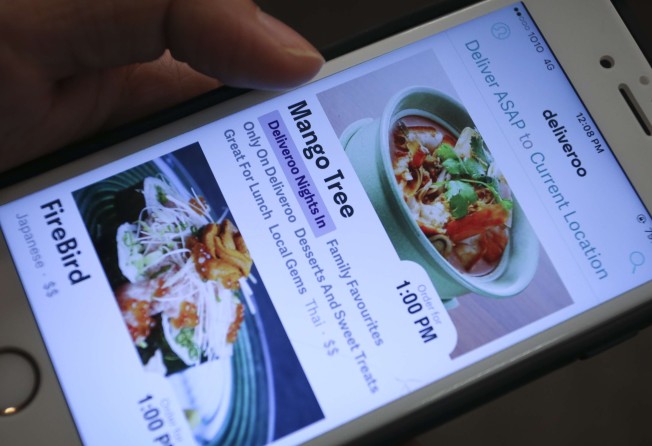
Food delivery services aim to make our lives easier with just a few taps on an app, but it’s not all peaches and cream, as we found talking to regular users and trying some ourselves. They also have their fair share of blunders and bugs, in some cases literally.
Speaking from Los Angeles, foodie Wendy Wu says: “Once I ordered salads on Doordash [a food courier in the US), but a cockroach climbed out of the bag. I screamed.”
Another food delivery service user, Adaobi Ugoagu, also in LA, says: “For my first order with UberEats, the GPS showed that the driver had arrived. I went outside and there was nobody there. I called the driver and the person who answered told me I had called the wrong number. I feel like the driver ran off with my food.”
No stories of creepy crawlies emerged in Hong Kong, thankfully, where three dominant courier services – Foodpanda, Deliveroo and UberEats – are slugging it out, but there are niggles.
“You can tell both Deliveroo and Foodpanda’s priority is to get the food there on time, as most of my deliveries have arrived squashed against the side of the box,” regular courier user Caryn Yap says. “The one time we ordered sushi, it arrived as sashimi, and blobs of rice had stuck to one corner of the box.”
Another user, David Tang, says: “I ordered food on UberEats and I saw [on the tracking function] that the driver was arriving. But I did not receive any call.
“So I tried to call the driver more than 10 times, but the number was not reachable. In the end, I was charged more than HK$300 without receiving any food. I contacted their customer services department but they replied two days later and said nothing could be done.”
Food courier services in Hong Kong have undergone rapid expansion, a hi-tech makeover and an industry shake-up since Food by Phone became the first big name in the business in 1998.
Rocket Internet-backed Foodpanda has bought up most of its rival companies in Hong Kong since it entered the local market in 2014, such as Foodora, delivery.com and Food By Phone. But its dominance was shortlived, with the arrival of London-based start-up Deliveroo in 2015, and Silicon Valley based UberEats in 2016.
Basing ourselves in Causeway Bay, one of Hong Kong’s busiest shopping areas, we tried and tested the three companies to compare delivery times and services. For ease of comparison, we ordered green curry from three different Thai restaurants. The prices of dishes ordered through the apps tend to be HK$10 to HK$20 more expensive than those listed on menus. In addition, Foodpanda charges a deliver fee of HK$15, while the other two charge HK$20. The minimum order varies from restaurant to restaurant, but typically ranges from HK$60 to HK$85 before added fees.

Foodpanda
Having been around the longest, Foodpanda gets the jump on the other two. It features the widest selection of outlets, including bakeries, cafes and fast food chains. However, it also looks like the company has not updated the design of its mobile app since it launched.
The app is too wordy, and rather than showing appetising food photos, it displays the restaurants’ logos. It does not have a tracking function and, rather than sending notifications through the app, it texts you when the order is received and when the food is on its way.
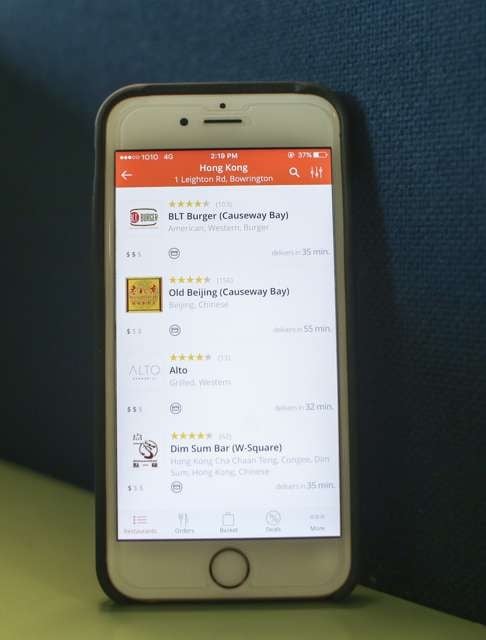
Although it has a rating system and allows users to write reviews, most are only a word or two long, so hardly a guide to good eating. In general, the app is difficult to navigate and does not make for a particularly enjoyable user experience.
On a positive note, at HK$15 Foodpanda has the loweest delivery charge, and it’s the only courier to accept cash on delivery or PayPal as a payment option.
Despite an estimated delivery time of 50 minutes, our order arrived within 40 minutes and the curry was still hot, at 70 degrees Celsius (the other two dishes were 55 to 60 degrees). We did not expect anything less, however, given that the restaurant from which we ordered, Lemongrass at Hysan Place, was only a five-minute walk away.
Combos, where the dish is paired with rice, are available from the restaurant or when you order by calling the restaurant directly. But on the app, customers must order the green curry (HK$108) and steamed rice (HK$20) separately.
Alex Roth, managing director of Foodpanda Hong Kong, said the company was working on a new app. To be launched in the coming months, it will allow more user customization and further streamline the ordering process.
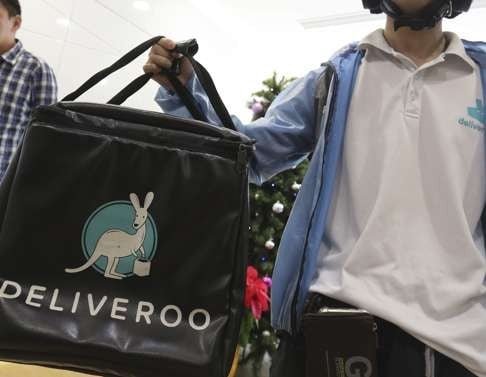
If you want Deliveroo to show up in your area, you can give the company a nudge by voting on the app.
Having expanded its reach to include Sham Shui Po, Kwai Fong and Tsuen Wan in December, Deliveroo now has the largest footprint among the three couriers. However, what truly makes it a winner is its mobile app, which has a beautiful and user-friendly design that outshines both its rivals.
It is way easier to change your personal details, such as phone number or name. Registration takes a matter of seconds: instead of inputting your credit card number, you can simply scan the card and you’re ready to order.
For some restaurants, customers can also add allergy alerts. Filters such as price range, types of cuisine and other useful and creative tags (perfect for sharing, local gems and, our favourite – guilty pleasures) make the selection process a lot easier.
We ordered the chicken green curry (HK$98 plus a HK$20 delivery fee) from Na Thai, in Happy Valley. The dish tasted quite good and, to our relief, came with rice. Deliveroo beats the other two in terms of services. Their delivery person was the only one to take time to enter the office lobby and confirm the order with us before handing over the food, which was neatly packaged in a paper bag, stapled with the receipt and a small pamphlet promoting Deliveroo’s services.
Brian Lo Ka-chung, Deliveroo’s Hong Kong managing director, says the company has ambitious goals for the coming year, among them extending its coverage to the entire city and doubling the number of restaurants on its books from around 1,500 currently to 3,000.
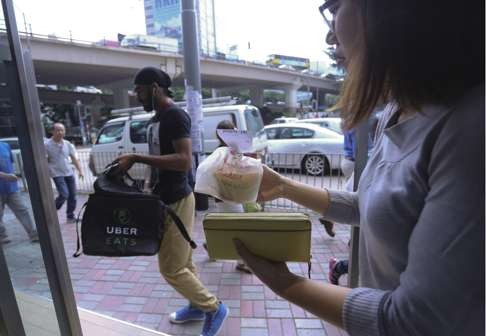
UberEats
Launched in October 2016, UberEats is the new kid on the block. In cities such as Johannesburg and Los Angeles, where Uber’s ride-sharing services are hugely popular, UberEats has been an instant hit. But in Hong Kong, its ride-hailing services have had a bumpy ride, so it hardly has an edge over its competitors.
UberEats initially fared well after its launch, by lavishing price discounts on new users, but that tactic will only give it so much leverage. To retain customers, it will have to step up its game.
UberEats covers a very limited area. It is available only in parts of Hong Kong Island and Kowloon, and has not indicated when it will expand its reach. It also trails its rivals in terms of customer services – while other companies provide live chat support so customers can contact them instantly, UberEats only lists an e-mail address on its website and it can take more than a day to get a reply. Customers can only resort to a list of answers to FAQs if in need of help on the spot.
There are other small annoyances. A search button is conspicuously absent from its website and changing your personal details is irritatingly difficult – rather than pressing the edit button in the settings, you have to log out and sign in again to change your phone number.
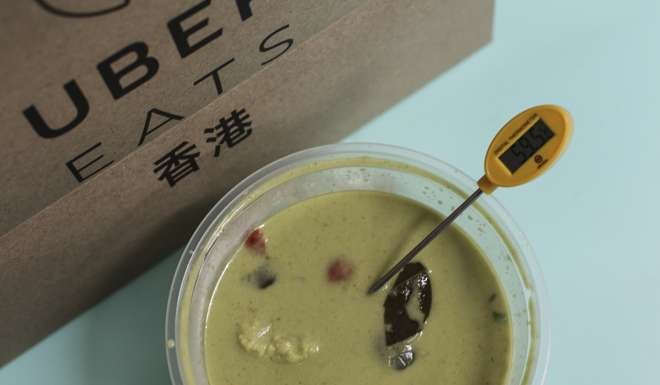
UberEats provide the fewest options in terms of restaurants. Just over 50 restaurants deliver to our location in Causeway Bay, while there are more than 100 on Deliveroo and close to 150 on Foodpanda.
UberEats has some intriguing entries, though, such as liquid nitrogen ice-cream from Lab Made or ice pops from iSEE iSEE Handcrafted Icy Desserts. To our delight, the Strawberry Hokkaido Milk we ordered from the latter arrived beautifully packaged and the dry ice added to the bag kept it from melting. However, it took more than 30 minutes to arrive because the delivery person could not find our building and we had to go out onto the street to find him instead. We might as well have walked to the shop ourselves, since it was only three blocks away.
The second delivery, a chicken green curry we ordered from Champion Thai Restaurant (HK$108 plus HK$20 delivery fee), was more successful, arriving minutes before the estimated delivery time. It didn’t come with steamed rice, which must be ordered separately for HK$18.